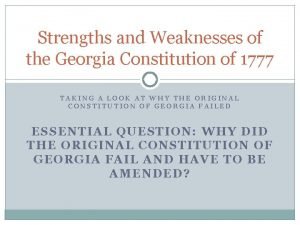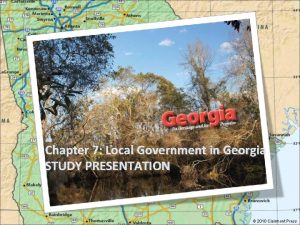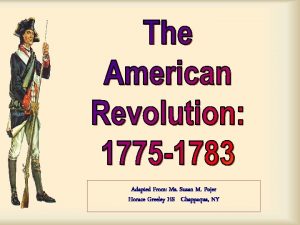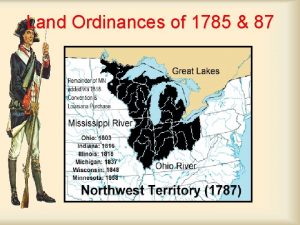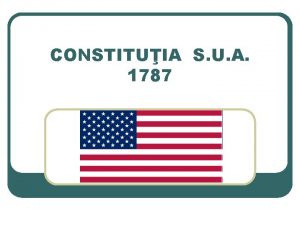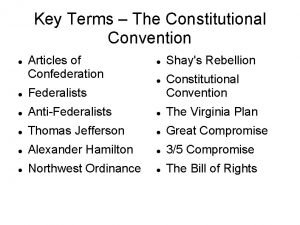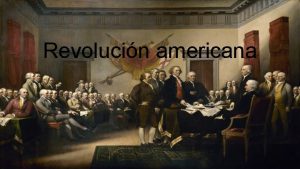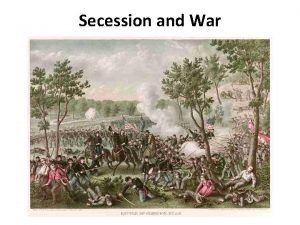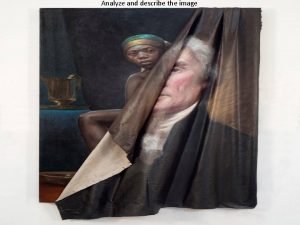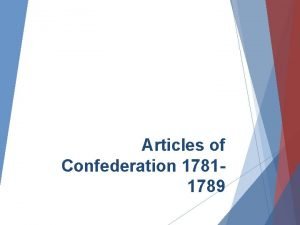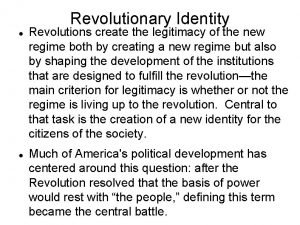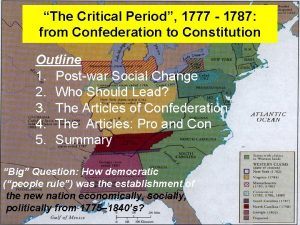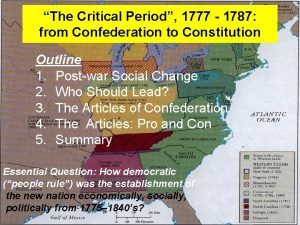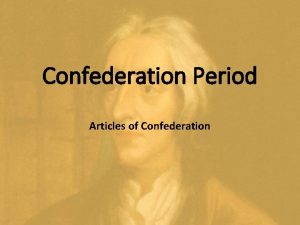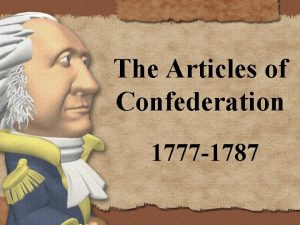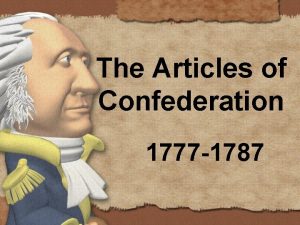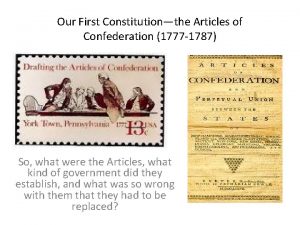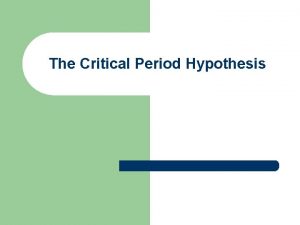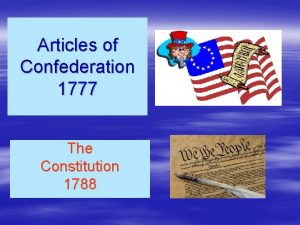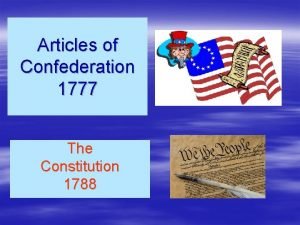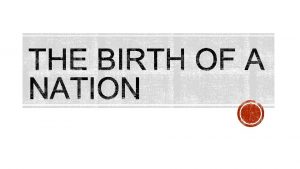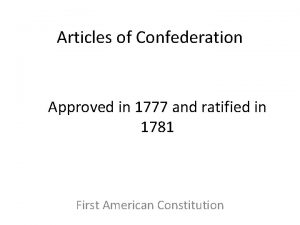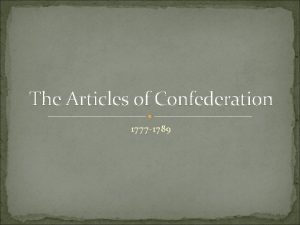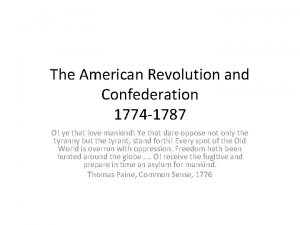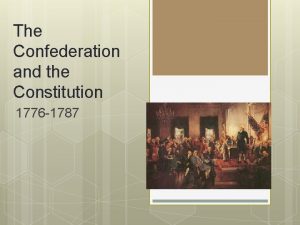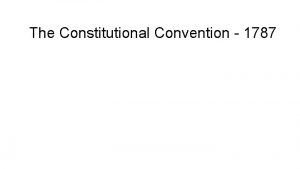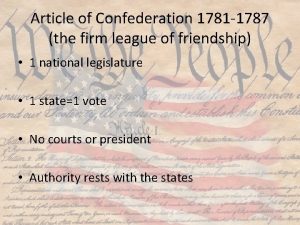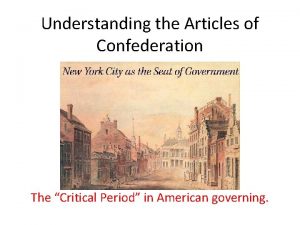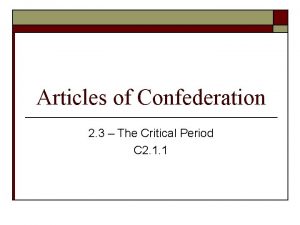The Critical Period 1777 1787 from Confederation to



























- Slides: 27

“The Critical Period”, 1777 - 1787: from Confederation to Constitution Outline 1. Post-war Social Change 2. Who Should Lead? 3. The Articles of Confederation 4. The Articles: Pro and Con 5. Summary Essential Question #2: How democratic (“people rule”) was the establishment of the new nation economically, socially, politically from 1760’s to the 1840’s?

Three questions tonight and throughout the course: What is history? What do we know about it, especially early American history? ? How do we know?

We will pursue our understanding of American history through Essential Questions - are open-ended, no single definitive answer - tie the past to the present - require analytical thinking (SHEG) and techniques - require primary and secondary sources - must be supported by American history content

“The Critical Period”, 1777 - 1787: from Confederation to Constitution 8 Questions The British ambassador to the new nation of the United States asked a rude question to point out what he saw as a flaw with the Confederation government.

“The Critical Period”, 1777 - 1787: from Confederation to Constitution Outline 1. Post-war Social Change 2. Who Should Lead? 3. The Articles of Confederation 4. The Articles: Pro and Con 5. Summary Essential Question #2: How democratic (“people rule”) was the establishment of the new nation economically, socially, politically from 1760’s to the 1840’s?

“The Critical Period”, 1777 - 1787: from Confederation to Constitution Women should have their own revolution too. - A. Adams

“The Critical Period”, 1777 - 1787: from Confederation to Constitution

“The Critical Period”, 1777 - 1787: from Confederation to Constitution Outline 1. Post-war Social Change 2. Who Should Lead? 3. The Articles of Confederation 4. The Articles: Pro and Con 5. Summary Essential Question #2: How democratic (“people rule”) was the establishment of the new nation economically, socially, politically from 1760’s to the 1840’s?

“The Critical Period”, 1777 - 1787: from Confederation to Constitution “When a man who is only fit to patch a shoe attempts to patch the State [country]. . . He cannot fail to meet with contempt. ” - James Otis, 1777

“The Critical Period”, 1777 - 1787: from Confederation to Constitution “Specious, interested, designing men. . . Men, respectable for their property, their virtue, nor their abilities. . . [are courting] the [voting] of the people by tantalizing them with improper indulgences. ” - Charleston [S. C. ] “Columbian Herald”, 1785

“The Critical Period”, 1777 - 1787: from Confederation to Constitution Many states had either a property requirement or tax payment requirement for white males to be eligible to vote.

“The Critical Period”, 1777 - 1787: from Confederation to Constitution Outline 1. Post-war Social Change 2. Who Should Lead? 3. The Articles of Confederation 4. The Articles: Pro and Con 5. Summary Essential Question #2: How democratic (“people rule”) was the establishment of the new nation economically, socially, politically from 1760’s to the 1840’s?

“The Critical Period”, 1777 - 1787: from Confederation to Constitution Grammar lesson, 1786: The United States _____ a great place to live. (form of “to be”)

“The Critical Period”, 1777 - 1787: from Confederation to Constitution The “first draft” for a national government: The Articles of Confederation, 1777 - 1787

“The Critical Period”, 1777 - 1787: from Confederation to Constitution Imagine a rebellious teenager who resented his/her parents’ restrictive rules on cleaning the house, who he/she may associate with, and curfew. Now he/she lives on his own for the first time. What will be his/her rules for the above?

“The Critical Period”, 1777 - 1787: from Confederation to Constitution Under the British government. . . Under the Articles. . . (“parents”) (“rebellious teenager” gov’t) 1. The king was a “tyrant” 1. 2. Parliament was too big and 2. impersonal 3. The courts always ruled in 3. favor of government policies 4. Parliament taxed us without our 4. consent 5. The Navigation Acts restricted 5. which nations and what we could trade 6. “redcoats” enforced laws and 6. created a “presence”

“The Critical Period”, 1777 - 1787: from Confederation to Constitution Under the British government. . . 1. 2. 3. 4. 5. 6. The king was a “tyrant” Parliament was too big and impersonal The courts always ruled in favor of government policies Parliament taxed us without our consent The Navigation Acts restricted which nations and what we could trade “redcoats” enforced laws and created a “presence” Under the Articles. . . (“rebellious teenager” gov’t) 1. no executive/”king” 2. single house legislature 3. no national judiciary 4. no taxation power 5 no power to regulate trade 6. no national army

“The Critical Period”, 1777 - 1787: from Confederation to Constitution Congress could also manage Western lands and mint a national currency.

“The Critical Period”, 1777 - 1787: from Confederation to Constitution Outline 1. Post-war Social Change 2. Who Should Lead? 3. The Articles of Confederation 4. The Articles: Pro and Con 5. Summary Essential Question #2: How democratic (“people rule”) was the establishment of the new nation economically, socially, politically from 1760’s to the 1840’s?

“The Critical Period”, 1777 - 1787: from Confederation to Constitution 8 Questions The British ambassador to the new nation of the United States asked a rude question to point out what he saw as a flaw with the Confederation government.

“The Critical Period”, 1777 - 1787: from Confederation to Constitution OR

“The Critical Period”, 1777 - 1787: from Confederation to Constitution Outline Settling western land claims and avoiding “megastates” was Articles greatest achievement. 4. The Articles: Pro and Con

“The Critical Period”, 1777 - 1787: from Confederation to Constitution

“The Critical Period”, 1777 - 1787: from Confederation to Constitution

“The Critical Period”, 1777 - 1787: from Confederation to Constitution

“The Critical Period”, 1777 - 1787: from Confederation to Constitution “Good God! There are combustibles in every state which a spark may set fire to!” - G. Washington Shays’ Rebellion, 1786

“The Critical Period”, 1777 - 1787: from Confederation to Constitution Outline 1. Post-war Social Change 2. Who Should Lead? 3. The Articles of Confederation 4. The Articles: Pro and Con 5. Summary Essential Question #2: How democratic (“people rule”) was the establishment of the new nation economically, socially, politically from 1760’s to the 1840’s?
 Critical semi critical and non critical instruments
Critical semi critical and non critical instruments Critical semi critical and non critical instruments
Critical semi critical and non critical instruments Critical period vs sensitive period
Critical period vs sensitive period Critical period vs sensitive period
Critical period vs sensitive period Cynthia lightfoot
Cynthia lightfoot Critical period vs sensitive period
Critical period vs sensitive period Primer angulo de proyeccion
Primer angulo de proyeccion What are the concerns of the constitutions?
What are the concerns of the constitutions? Georgia constitution of 1777
Georgia constitution of 1777 Georgia constitution of 1777 strengths and weaknesses
Georgia constitution of 1777 strengths and weaknesses Georgia constitution of 1777
Georgia constitution of 1777 Johann carl friedrich gauß
Johann carl friedrich gauß Northwest ordinance of 1787
Northwest ordinance of 1787 Northwest ordinance of 1787
Northwest ordinance of 1787 Estates general
Estates general Northwest ordinance of 1787
Northwest ordinance of 1787 French revolution calender
French revolution calender Constitutia sua 1787
Constitutia sua 1787 Northwest ordinance of 1787
Northwest ordinance of 1787 Northwest ordinance of 1787
Northwest ordinance of 1787 Independencia eeuu
Independencia eeuu Compromise
Compromise Northwest ordinance of 1787
Northwest ordinance of 1787 Constitutional convention 1787
Constitutional convention 1787 Northwest ordinance of 1787
Northwest ordinance of 1787 Usa 1787
Usa 1787 1787-1776
1787-1776 Compare non-critical readers with critical readers.
Compare non-critical readers with critical readers.









